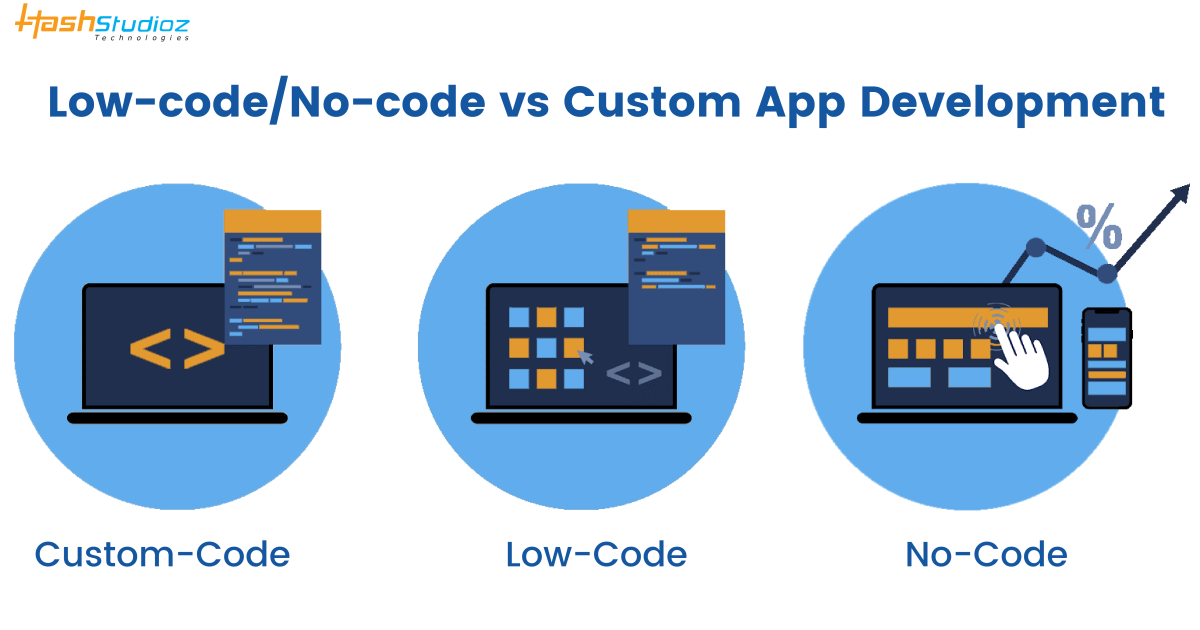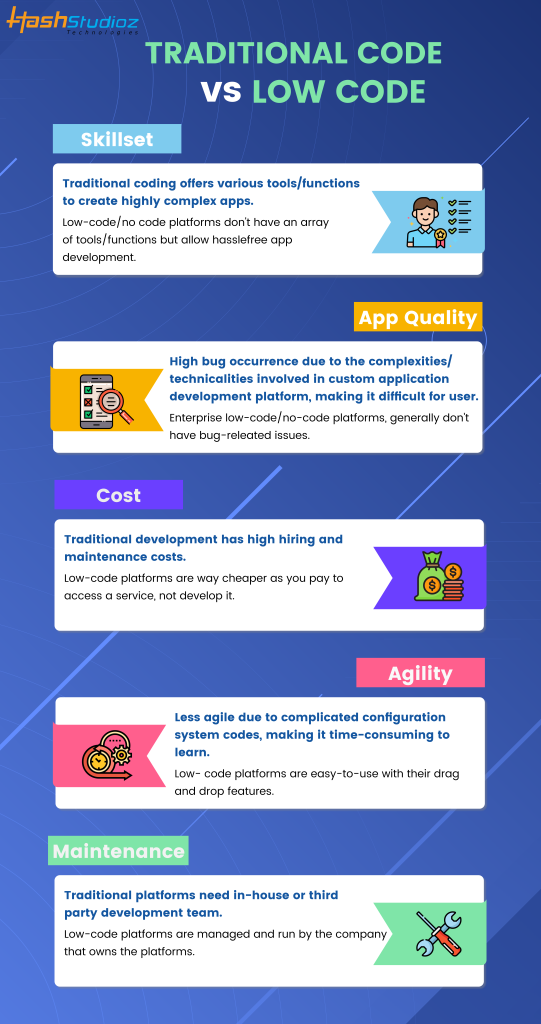Low-code app development has many benefits, especially in terms integration. This is crucial in creating apps that seamlessly connect with platforms and services. Here are some benefits of APIs and connectors that are pre-built:
A Wide Variety of Connectors: Low-code platforms typically come with a vast library of pre-built connectors to the most popular enterprise software (e.g. ERP, CRM, databases, and cloud services). This makes it easier to integrate with these systems.
API Integration: Many Low-Code platforms come with out-of-box API integration features that allow developers to easily connect external services and data resources.
Easy to Utilize:
Drag-and-Drop Interfaces: A variety of integration tasks can easily be accomplished using drag-and-drop interfaces. This allows for developers and others who are not developers to create complex systems without lengthy programming.
Visual Workflow Builders : Tools to create workflows and data flow that are visualized help comprehend and setup integrations in a more intuitive method.
Standardized Integration Methods:
SOAP/RESTful Service Support: Standard web service protocols, like SOAP/REST, facilitate the integration of various different systems and applications.
OData and various Standards Standards that support them such as OData allows for easy access to and manipulation of data on different platforms and programs.
Real-Time Data Synchronization:
Real-Time Integrations: Lowcode platforms handle data synchronization at a real-time rate between the system and applications to ensure that data is up-to-date and consistent across an organisation.
Event-Driven Architecture: Certain platforms can support event-driven architectures. which allow applications to react to events in real-time, which is vital for interactive and dynamic apps.
Legacy System Integration:
Low-code platforms are frequently employed to integrate systems from the past. This enables organizations to modernize IT infrastructures without the need to completely overhaul the existing systems.
Data Migration Tools: Built-in software helps transfer data from older applications to new ones that are built on platforms that have low-code.
Integration of Third-Party Services:
Cloud Services Integration: The seamless integration of cloud services like AWS Azure, Google Cloud, allows for easy deployment and scaling-up of applications.
Business Applications Integration: Low-code platforms are able to integrate with different business applications like Salesforce, SAP, Microsoft Dynamics, etc., enabling a cohesive workflow across different business functions.
Simple Data Management:
Unified data models: Certain platforms that offer low-code support for unified data models to facilitate data management across different systems.
Data Connectors - Pre-configured connectors which allow for simple access to, as well as manipulation of, data from diverse sources.
Security and Compliance
Secure Integrations Low-Code platforms are designed to ensure that all integrations conform to the security protocols and standards. This ensures the security of the data in transit as well as when it is stored.
These platforms are typically equipped with features that ensure compliance (e.g. HIPAA, GDPR) and give peace of mind to businesses handling sensitive information.
Extensibility:
Custom Codes and Scripts. To meet more intricate requirements for integration, low-code platforms typically allows for the integration of custom scripts and code. This allows flexibility without compromising user convenience.
Plug-in Ecosystem : An ecosystem of plugins and extensions that will enhance integration capabilities through allowing users to easily add new functionality as required.
In the end, the integration capabilities of low-code applications development platforms makes them an excellent tool for creating interconnected, efficient and scalable applications. These platforms simplify the process of connecting different IT systems, increase the flow of data, and aid businesses adopt existing technologies, while also leveraging new ones. See the recommended Low-code Platform for application development for site tips including rad development, push alerts, application modernisation, cross platform app development, microsoft azure sql, no code platforms, rapid action development, rad application development, cloud software applications, cross platform app dev and more.

Benefits Of Developing Applications Using Low-Code In Terms Of Cost-Efficiency
The low-code approach to app development is a cost-effective option with many benefits. It's an excellent choice for companies looking to maximize their budgets as well as create high-quality apps. Here are a few of the key benefits.
Lower Coding Requirement: Lower Coding platforms remove the need to write code manually and save developers time and money. This results in lower costs for labor.
We have fewer resources available for developers: Low-code programming is faster and easier, so less developers with specialization are required. This can drastically reduce the need for hiring and staffing expenses.
Time to market faster:
Accelerated Development: Low-code platforms provide visual development tools, pre-built components and other features that enable rapid development of applications. Businesses can bring their products to the market much faster. This could result in increased revenue as well as improved positioning in the market.
Rapid Prototyping. Businesses can test quickly and create prototypes. This cuts down time during the development phase, and permits rapid iterations dependent on the feedback of users.
Lower Maintenance Costs
Simple Maintenance: Applications developed with low-code platforms are typically more simple to maintain due to their standard components and modular architecture. This means that they are less likely to require ongoing maintenance and support cost.
Automated Updates - Many low-code systems are capable of handling updates and patches in a manner that's safe and efficient. This eliminates the need for manual intervention.
Efficient Resource Utilization:
Low-code platform contributions allow businesses as well as other non-developers to participate in the creation process. This decentralization of the development process permits companies to tap into the expertise and expertise of a greater variety of employees.
Utilizing IT resources efficiently: IT departments have the chance to concentrate on more strategic projects, instead of being bogged-down with routine work tasks for development. Overall efficiency and productivity are increased.
Scalable Pricing Models
Subscription-Based Pricing: A lot of low-code software providers offer flexible subscription-based pricing that can scale with usage. Businesses are able to adjust their spending in line with their growth and needs, without having to pay large upfront costs.
Pay-Ass-You-Go Options: Certain platforms offer pay-as-you-go options that make sure businesses only pay when they make use of resources. This is particularly beneficial for small and start-up companies with small budgets.
Reduction in Third-Party Software Costs:
Built-in Functionalities : A low-code platform often comes with built-in functionality and integrations, which eliminates the requirement for additional third-party tools, software and licenses.
Pre-Built Integrations: The availability pre-built integrations with the most well-known systems and services reduces the need for the need for custom-designed development. This saves time as well as cash.
Increased ROI:
More efficient return on investment (ROI) by making use of the rapid development process, reduced costs and a shorter time to the market, companies are able to achieve a faster ROI for their apps.
Increased Agility: Businesses are able to quickly adjust to changes in the market and to changing customer demands. This helps them remain current and take advantage of opportunities that arise.
Lower Training Costs
Low-Code Platforms Have User-Friendly Interfaces. The user-friendly and intuitive interfaces help ease the learning curve of novice users. This reduces the requirement for extensive training programs.
Accessible Resources. Many low-code platforms provide comprehensive training material and tutorials as well as community support. They reduce the need to attend formal training which can be costly.
Collaboration is simplified:
Enhanced Collaboration Tools: Built-in tools for collaboration facilitate better communication and coordination among team members, leading to better development processes and a reduction in project costs.
Unified Development Environment. A single integrated software development environment can simplify processes and reduce the complexity and expense of managing different software and platforms.
In general, low-code applications are cost-effective because of their ability to lower the cost of maintenance and development as well as to speed time-to-market, to optimize resource usage and also to offer flexibility in pricing. This combination of factors offers companies significant financial advantages and makes low-code an appealing choice for companies looking to maximize development budgets, while still achieving robust and adaptable applications. View the most popular Legacy application modernization with Low-code tips for website recommendations including push notifications android, database in azure, driver jdbc, app modernisation, develop cross platform mobile app, database in azure, mobile app development platforms, rapid applications, azure sql server, azure sql and more.

Benefits Of Low-Code Application Development In Terms Of Collaboration And Workflow
Low-code application development is a good choice for businesses who want to boost team productivity by streamlining the development process. Here are the top benefits: Improved Cross-Functional Collaboration:
Unified Development Environment. Low-code platforms enable all team members to work in a single and unifying environment. This includes business analysts, developers and designers as well as stakeholder. This eliminates silos and fosters more effective communication.
Visual Development Tool: The drag-and-drop nature of platforms that utilize low-code makes it easier for team members who aren't technical to be involved in the process of development. They are able to ensure that business requirements will be accurately captured and implemented.
Communication Improved:
Real-Time Co-operation: A lot of platforms that have low-code support live-time collaboration features such as commenting, editing simultaneously, and receiving immediate feedback. They allow for continuous communication by reducing the amount of time required for back-and-forth discussions.
Shared workspaces: Teams are able to work in tandem on shared workspaces in which they edit and discuss the project's elements. This ensures that everyone is striving for the same objectives and is on the same team.
Streamlined Workflow Management:
Built-in Project Management Tools: Low-code platforms often have integrated tools for managing projects which help teams plan, track, and manage their development projects. This includes assigning tasks, tracking progress as well as deadline management.
Workflow Automation: Automating repetitive tasks and workflows can reduce manual mistakes and work, allowing the team to concentrate on strategic activities while improving efficiency.
More efficient Iteration Cycles
Rapid prototyping. Low-code platform enables rapid prototyping. This allows feedback to be quickly integrated and improvements can be made.
Agile Development Support: Support for agile methodologies allows teams to be working in sprints, constantly offering small increments of functionality, making it easier to adapt to changing requirements.
Accessibility:
Citizen Development: Low code platforms enable users in the business (citizens developers) to create and modify their applications without any prior knowledge of programming. This relieves IT and Development teams of burdens and allows quicker responses to business needs.
Training and onboarding. Tools that are intuitive and comprehensive training materials can help a new team member get up-to-speed increasing the overall quality of collaboration.
Centralized Documentation & Knowledge Sharing
Integrated Documentation : Low-code platforms offer a wide range of tools that permit the creation and maintenance of documentation within the platform. This makes sure that all information related to the project is centrally located and accessible.
Knowledge Repositories. Teams are able to develop and maintain knowledge repositories that include best practices templates and reusable component, facilitating sharing of knowledge and decreasing duplicate effort.
Consistency in Standardization
Standardized Components: The use of standardized, pre-built components provides the sameness across applications, making it simpler for teams to comprehend and collaborate on various aspects of an undertaking.
Governance and compliance Frameworks built-in for governance ensure that all applications are created in line with the organizational standards, regulations requirements, and the quality standards. They minimize the chance of not adhering to regulations and assure that the application meets the requirements of the standards.
Feedback loops:
Integrated Feedback mechanisms: Platforms with low-code often have integrated feedback mechanisms, which allow users to give their feedback on the application. Feedback can then become incorporated into development.
Continuous Improvement: The capacity for applications to iterate quickly and implement changes based off of feedback, while ensuring they are in tune with the user's needs and business objectives.
Visualization & Reporting
Real-time Analytics: In-built analysis and reporting provides real-time information about the performance of your project, user interactions and development. Data-driven decision-making is feasible.
Visual Workflow Mapping Visual tools for mapping processes and workflows help teams understand and optimize their workflows, identifying bottlenecks and areas for improvement.
Low-code application development has many advantages in collaboration and workflow. These include the ability to bring different teams together in one space, simplify communication and streamline certain processes. This encourages a collaborative environment with an agile and efficient development process that results in more high-quality apps as well as a better alignment between goals of business.
